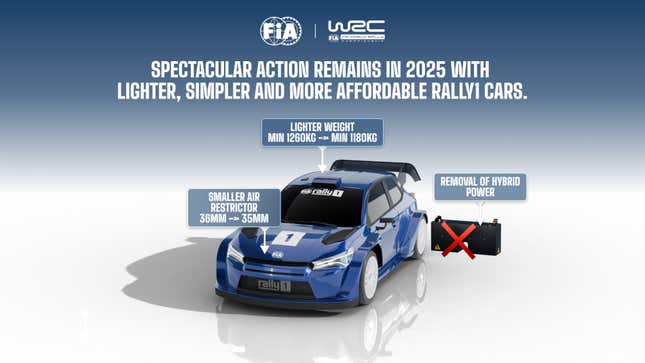The World Rally Championship has always positioned itself as the pinnacle of international rally competition, and the move to hybrid powertrains for the 2022 season was indicative of its desire to be a technology test bed for the manufacturers in the sport while increasing the power, speed, and spectacle of the top Rally1 class. Effective last weekend, the FIA has decided to scrap the whole plan and take a few giant steps backward with simpler lower-power cars.
The 2024 cars made around 380 horsepower from a 1.6-liter engine and 134 horsepower from the spec Compact Dynamics hybrid system. That combined 514 horsepower pushed 2778 pounds around for a power-to-weight ratio of 0.18:1 (or 5.4 pounds per horsepower). Not only are the 2025 cars ditching the hybrid system, but they’ll be subject to a one-millimeter-smaller air restrictor as well, dipping engine outputs slightly. For the purposes of this blog, let’s say the new cars will make around 370 horsepower. The FIA has determined the new minimum weight for Rally1 will be 2601.5 pounds, giving them a power to weight ratio of 0.14:1 (or 7 pounds per horsepower).

The FIA claims the new cars will provide similar pace to the 2024 specification hybrid machines, but considering the massive power-to-weight disadvantage, I can’t see how.
FIA President Mohammed Ben Sulayem said: “The rich heritage and unique appeal of this sport, which is so dear to my heart, are invaluable, and we are committed to safeguarding its future. This development is important not only for the championship’s stakeholders to adapt to the evolving energy landscape, but also for containing costs. By focusing on sustainable fuel and simplifying car technology, we’re ensuring the WRC remains captivating for fans and achievable for competitors.”
The main benefit of scrapping the hybrid system is a reduction in operating expenses for the factory-backed Ford, Hyundai, and Toyota teams. Ford, it seems, has enough money to support a hybrid Formula One engine effort with Red Bull, but can’t find justification for continuing to support a top team running hybrids in the series most closely tied to its production road-going products. Make it make sense.
Hyundai and Toyota initially pushed back against a rumored hybrid exit, and the series voted to extend the hybrid system supply through the end of 2026. Earlier this year, however, a new regulation was added to cover hybrid unit safety. The new rule required any power unit receiving three hits over 15G or one over 25 would have to be stripped from the car and sent back to Compact Dynamics for rebuilding. The previous regulations allowed for on-site repair by the teams.
“It is not a request to remove it for what it is, it is a request to remove it because we can’t actually repair and run them at an economic price for M-Sport. We are talking a few extra million euro to do it and that is not something we can deal with,” M-Sport team principal Richard Millener told Motorsport.com.
Hyundai’s team principal Cyril Abiteboul added: “We will never actively or proactively request to remove the hybrid from WRC. Having said that, we also need to be pragmatic and recognize the fact that the WRC community is a small community, and as any small community, we need to look after one another.”
This is supposed to be a boundary-and-technology-pushing rally series. I don’t know what made Ford think racing at the top of an FIA category would be inexpensive.


